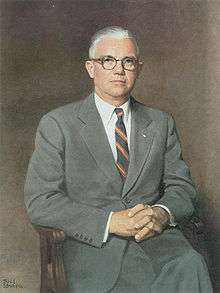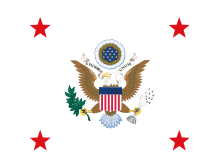Robert T. Stevens
| Robert T. Stevens | |
|---|---|
 Robert Ten Broeck Stevens oil painting by Thomas Edgar Stephans | |
| 4th United States Secretary of the Army | |
|
In office February 4, 1953 – July 21, 1955 | |
| President | Dwight D. Eisenhower |
| Preceded by | Frank Pace |
| Succeeded by | Wilber M. Brucker |
| Personal details | |
| Born |
July 31, 1899 Fanwood, New Jersey |
| Died |
January 31, 1983 (aged 83) Edison, New Jersey |
| Parents |
John Peters Stevens Edna Ten Broeck |
| Alma mater |
Phillips Academy (1917) Yale University |
Robert Ten Broeck Stevens (July 31, 1899 – January 31, 1983) was a U.S. businessman and former chairman of J.P. Stevens and Company, which was one of the most established textile manufacturing plants in the U.S.[1] He served as the Secretary of the Army between February 4, 1953 until July 21, 1955. [2]
Biography
He was born on July 31, 1899 in Fanwood, New Jersey to John Peters Stevens and Edna Ten Broeck. He attended Phillips Academy and graduated in 1917. He then attended Yale University. He became president of J.P. Stevens and Company in 1929.[1] It is now part of a conglomerate—WestPoint Home.
He served as Chairman of The Business Council, then known as the Business Advisory Council for the United States Department of Commerce in 1951 and 1952.[3]
Stevens came into conflict with Senator Joseph McCarthy over a series of issues that ultimately led to the Army-McCarthy hearings of 1954. In the fall of 1953, McCarthy began an investigation into the United States Army Signal Corps laboratory at Fort Monmouth. McCarthy's aggressive questioning of Army personnel was damaging to morale, but failed to reveal any sign of the "dangerous spies" that McCarthy alleged to exist.[4] Next McCarthy investigated the case of Irving Peress, an Army dentist who had refused to answer questions in a loyalty-review questionnaire.
As various officers, scientists and other Army staff were subjected to McCarthy's often abusive questioning, Stevens was criticized for capitulating to many of McCarthy's demands and not supporting his men.[5][6]
Concurrent with these events, McCarthy's chief counsel, Roy Cohn, had been pressuring the Army, including Stevens, to give preferential treatment to his friend G. David Schine, who had recently been drafted. The Army-McCarthy hearings were held to investigate the Army's charge that McCarthy and Cohn were making improper demands on behalf of Schine, and McCarthy's counter charge that the Army was holding Schine "hostage" in an attempt to halt McCarthy's investigations into the Army. During the hearings, McCarthy questioned Stevens for several days. Although Stevens is generally considered to have handled the hearings poorly,[7] it was McCarthy who fared worst in the month-long investigation. The exposure before a television audience of McCarthy's methods and manners during the hearings are credited with playing a major role in his ultimate downfall. Stevens wanted to resign after the incident but Vice-President Richard Nixon convinced him not to.
J. P. Stevens & Company
Robert T. Stevens had a fifty-year career with J. P. Stevens & Company—named after New York-based John Peter Stevens who made his fortune by selling the products of his grandfather's Massachusetts-based family business which dated back to the War of 1812.[1][8] Under John Peter Stevens it became one of the largest textile companies in the United States with mills in the North and South.[8] By the age of thirty Robert T. Stevens was president of the company.[1] During his tenure it was "one of the world's largest, most diversified textile organizations."[1] He left Stevens for two-years to serve as Secretary of the Army and by July 1955 he returned to Stevens where he remained until his retirement.[2] He became director emeritus in 1974.[1]
Like many other companies in post-World War II United States, Stevens moved the company south specifically because he "wanted to pay lower wages and avoid unions."[9]:707
By 1963 Stevens was the second-largest company in the United States with 36,000 employees—mainly in the Southern states.[9] For that reason it was selected by the union as the target of a major organizing campaign. Stevens's employees earned "wages that were well below the manufacturing average, and they had few benefits."[9][10] Stevens resented his company being singled out by the union, and made an aggressive stand. From 1963 to 1980 the company and the union entered into a bitter struggle that became known as the J. P. Stevens campaign or controversy.[9]:707[9]:707[11][12]:124[13]:53–64, 246–249[14][15][16][17]:251–272[18]:26–31[19][20]:282–298[21]
Personal life
His children include Bob Stevens from Helena, Montana, J. Whitney Stevens from New York, and Tom Stevens from Florida. The family still owns an est. 45,000-acre (180 km2) cattle ranch called the American Fork in Two Dot, Montana.
He died on January 30, 1983 in Edison, New Jersey.[1]
References
- 1 2 3 4 5 6 7 Robert D. McFadden (February 1, 1983). "Robert T. Stevens, Former Army Secretary, Dies At 83". New York Times. Retrieved 2013-12-23.
Robert T. Stevens, a former Secretary of the Army who became a major figure in the 1954 Army-McCarthy hearings that led to the condemnation of Senator Joseph R. McCarthy and the collapse of his anti-Communist campaigns, died Sunday at his home in Edison, N.J. He was 83 years old. ... Robert Ten Broeck Stevens was born on July 31, 1899, in Fanwood, N.J., the son of John Peters and Edna Stevens. ...
- 1 2 Bell, William Gardner (1992). "Robert Ten Broeck Stevens". Secretaries of War and Secretaries of th Army: Portraits and Biographical Sketches. United States Army Center of Military History. Retrieved September 22, 2007.
- ↑ The Business Council, Official website, Background
- ↑ Stone, Geoffrey R. (2004). Perilous Times: Free Speech in Wartime from the Sedition Act of 1798 to the War on Terrorism. W. W. Norton & Company. p. 384. ISBN 0-393-05880-8.
- ↑ Klingaman, William K. (1996). Encyclopedia of the McCarthy Era. Facts on File. p. 350. ISBN 0-8160-3097-9.
- ↑ Fried, Richard M. (1990). Nightmare in Red: The McCarthy Era in Perspective. Oxford University Press. p. 138. ISBN 0-19-504361-8.
- ↑ Adams, John G. (1983). Without Precedent: The Story of the Death of McCarthyism. W. W. Norton & Company. ISBN 0-393-30230-X.
- 1 2 "J. P. Stevens". Encyclopedia Britannica. nd. Retrieved 2 April 2016.
- 1 2 3 4 5 Minchin, Timothy (November 16, 2006), Arnesen, Eric, ed., J. P. Stevens Campaign (1963-1980), Encyclopedia of U.S. Labor and Working-class History, 1, Routledge, ISBN 0415968267
- ↑ Salmans, Sandra (October 18, 1981), J. P. Stevens: One year after the truce, retrieved March 31, 2016
- ↑ Fink, Joey (July 15, 2014). "In Good Faith: Working-Class Women, Feminism, and Religious Support in the Struggle to Organize J. P. Stevens Textile Workers in the Southern Piedmont, 1974–1980". Southern Spaces. Retrieved 26 August 2014.
- ↑ Patton, Randall L. (1999), "Carpet capital: the rise of a new south industry", University of Georgia Press
- ↑ Hodges, James A., Fink, Gary M.; Reed, Merl E., eds., J.P.Stevens and the Union: Struggle for the South, Race, Class, and Community in Southern Labor History, Tuscaloosa: University of Alabama Press
- ↑ Conway, Mimi (1979). Rise Gonna Rise: a Portrait of Southern Textile Workers. Garden City, N.Y.: Anchor Press/Doubleday.
- ↑ Daniel, Clete (2001). Culture of Misfortune: an Interpretive History of Textile Unionism in the United States. Ithaca, NY: ILR.
- ↑ Guzzardi, Walter Jr. (June 19, 1978), "How the Union got the upper hand on J. P. Stevens", Fortune, pp. 86–89, 91, 94, 98
- ↑ Hodges, James A. (1997), Zieger, Robert H., ed., The Real Norma Rae, Southern Labor in Transition, 1940-1995, Knoxville: The University of Tennessee Press
- ↑ Kovler, Peter (Spring 1979), "The South: Last Bastion of the Open Shop", Politics Today
- ↑ Minchin, Timothy (2005). Don’t Sleep with Stevens!: The J.P. Stevens Campaign and the Struggle to Organize the South, 1963-1980. Gainesville: University of Florida Press. ISBN 0813028108.
- ↑ Toplin, Robert Brent (Spring 1995), "Norma Rae: Unionism in an Age of Feminism", Labor History
- ↑ Truchil, Barry E. (1988), Capital Labor Relations in the U.S. Textile Industry, New York: Praeger Press
| Government offices | ||
|---|---|---|
| Preceded by Frank Pace |
United States Secretary of the Army February 1953 – July 1955 |
Succeeded by Wilber M. Brucker |

